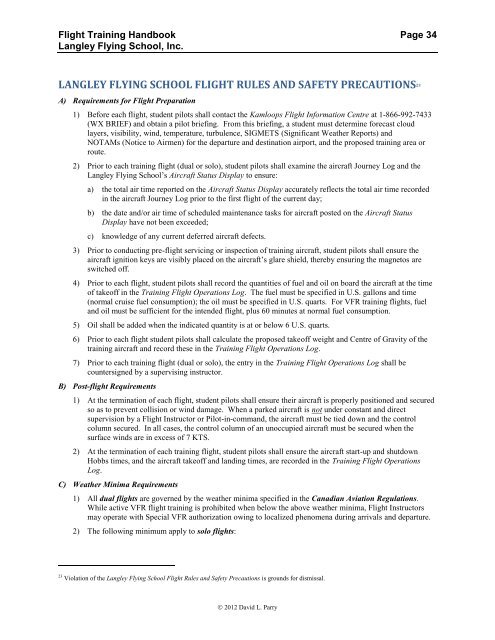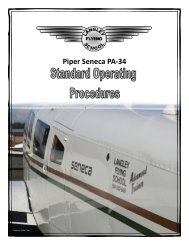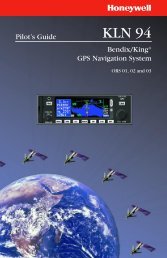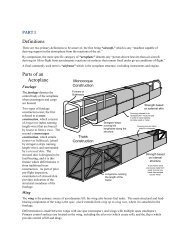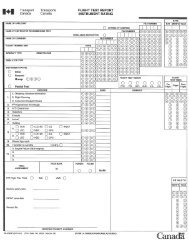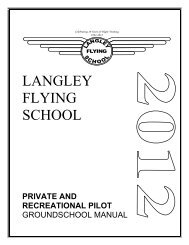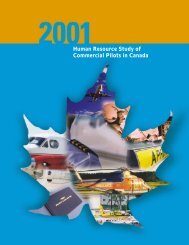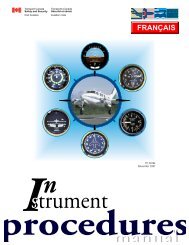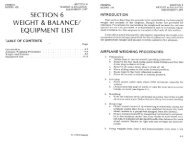LANGLEY FLYING SCHOOL Flight Training Handbook
LANGLEY FLYING SCHOOL Flight Training Handbook
LANGLEY FLYING SCHOOL Flight Training Handbook
You also want an ePaper? Increase the reach of your titles
YUMPU automatically turns print PDFs into web optimized ePapers that Google loves.
<strong>Flight</strong> <strong>Training</strong> <strong>Handbook</strong> Page 34<br />
Langley Flying School, Inc.<br />
<strong>LANGLEY</strong> <strong>FLYING</strong> <strong>SCHOOL</strong> FLIGHT RULES AND SAFETY PRECAUTIONS 23<br />
A) Requirements for <strong>Flight</strong> Preparation<br />
1) Before each flight, student pilots shall contact the Kamloops <strong>Flight</strong> Information Centre at 1-866-992-7433<br />
(WX BRIEF) and obtain a pilot briefing. From this briefing, a student must determine forecast cloud<br />
layers, visibility, wind, temperature, turbulence, SIGMETS (Significant Weather Reports) and<br />
NOTAMs (Notice to Airmen) for the departure and destination airport, and the proposed training area or<br />
route.<br />
2) Prior to each training flight (dual or solo), student pilots shall examine the aircraft Journey Log and the<br />
Langley Flying School’s Aircraft Status Display to ensure:<br />
a) the total air time reported on the Aircraft Status Display accurately reflects the total air time recorded<br />
in the aircraft Journey Log prior to the first flight of the current day;<br />
b) the date and/or air time of scheduled maintenance tasks for aircraft posted on the Aircraft Status<br />
Display have not been exceeded;<br />
c) knowledge of any current deferred aircraft defects.<br />
3) Prior to conducting pre-flight servicing or inspection of training aircraft, student pilots shall ensure the<br />
aircraft ignition keys are visibly placed on the aircraft’s glare shield, thereby ensuring the magnetos are<br />
switched off.<br />
4) Prior to each flight, student pilots shall record the quantities of fuel and oil on board the aircraft at the time<br />
of takeoff in the <strong>Training</strong> <strong>Flight</strong> Operations Log. The fuel must be specified in U.S. gallons and time<br />
(normal cruise fuel consumption); the oil must be specified in U.S. quarts. For VFR training flights, fuel<br />
and oil must be sufficient for the intended flight, plus 60 minutes at normal fuel consumption.<br />
5) Oil shall be added when the indicated quantity is at or below 6 U.S. quarts.<br />
6) Prior to each flight student pilots shall calculate the proposed takeoff weight and Centre of Gravity of the<br />
training aircraft and record these in the <strong>Training</strong> <strong>Flight</strong> Operations Log.<br />
7) Prior to each training flight (dual or solo), the entry in the <strong>Training</strong> <strong>Flight</strong> Operations Log shall be<br />
countersigned by a supervising instructor.<br />
B) Post-flight Requirements<br />
1) At the termination of each flight, student pilots shall ensure their aircraft is properly positioned and secured<br />
so as to prevent collision or wind damage. When a parked aircraft is not under constant and direct<br />
supervision by a <strong>Flight</strong> Instructor or Pilot-in-command, the aircraft must be tied down and the control<br />
column secured. In all cases, the control column of an unoccupied aircraft must be secured when the<br />
surface winds are in excess of 7 KTS.<br />
2) At the termination of each training flight, student pilots shall ensure the aircraft start-up and shutdown<br />
Hobbs times, and the aircraft takeoff and landing times, are recorded in the <strong>Training</strong> <strong>Flight</strong> Operations<br />
Log.<br />
C) Weather Minima Requirements<br />
1) All dual flights are governed by the weather minima specified in the Canadian Aviation Regulations.<br />
While active VFR flight training is prohibited when below the above weather minima, <strong>Flight</strong> Instructors<br />
may operate with Special VFR authorization owing to localized phenomena during arrivals and departure.<br />
2) The following minimum apply to solo flights:<br />
23 Violation of the Langley Flying School <strong>Flight</strong> Rules and Safety Precautions is grounds for dismissal.<br />
2012 David L. Parry


